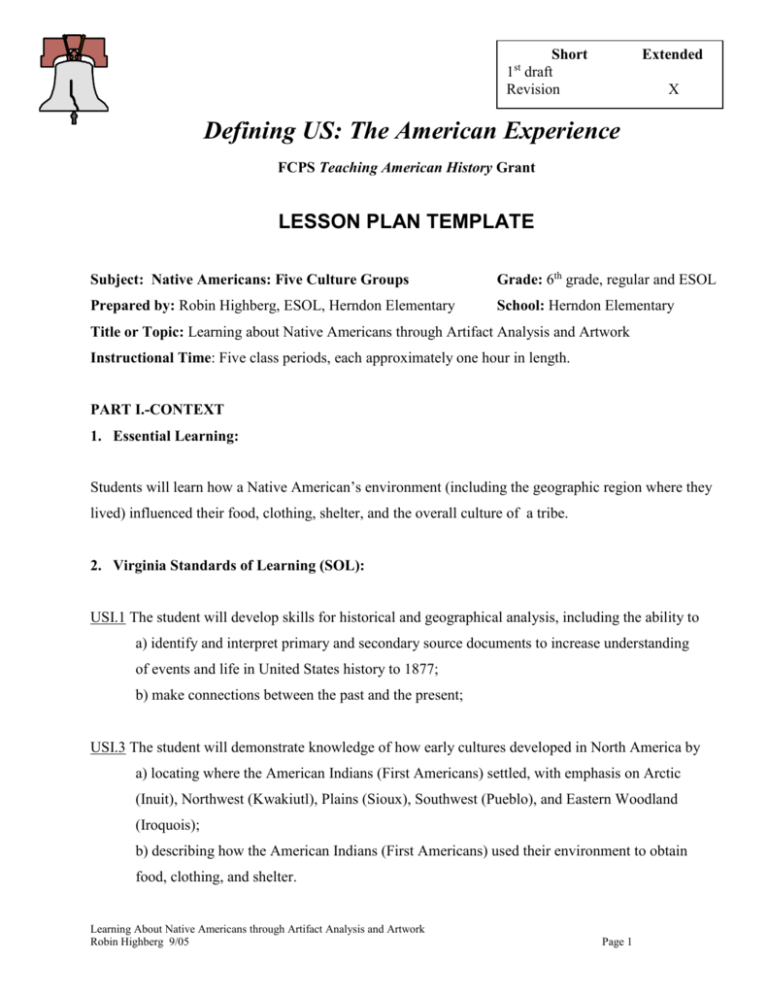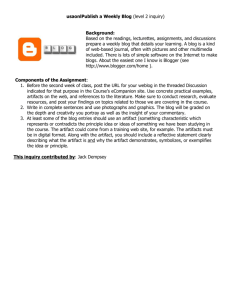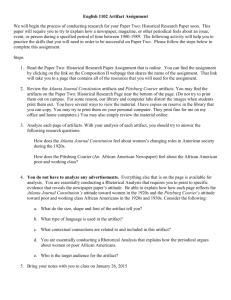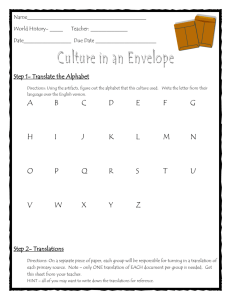Download/Print (Word .doc format)
advertisement

Short 1 draft Revision Extended st X Defining US: The American Experience FCPS Teaching American History Grant LESSON PLAN TEMPLATE Subject: Native Americans: Five Culture Groups Grade: 6th grade, regular and ESOL Prepared by: Robin Highberg, ESOL, Herndon Elementary School: Herndon Elementary Title or Topic: Learning about Native Americans through Artifact Analysis and Artwork Instructional Time: Five class periods, each approximately one hour in length. PART I.-CONTEXT 1. Essential Learning: Students will learn how a Native American’s environment (including the geographic region where they lived) influenced their food, clothing, shelter, and the overall culture of a tribe. 2. Virginia Standards of Learning (SOL): USI.1 The student will develop skills for historical and geographical analysis, including the ability to a) identify and interpret primary and secondary source documents to increase understanding of events and life in United States history to 1877; b) make connections between the past and the present; USI.3 The student will demonstrate knowledge of how early cultures developed in North America by a) locating where the American Indians (First Americans) settled, with emphasis on Arctic (Inuit), Northwest (Kwakiutl), Plains (Sioux), Southwest (Pueblo), and Eastern Woodland (Iroquois); b) describing how the American Indians (First Americans) used their environment to obtain food, clothing, and shelter. Learning About Native Americans through Artifact Analysis and Artwork Robin Highberg 9/05 Page 1 3. Fairfax County Program of Studies (POS): (Identify by number and descriptor.) Benchmark 6.2.1: Students conduct research and gather a variety of information for the purpose of analyzing data and making inferences regarding major historical events. Benchmark 6.6.2: Students identify the relationship between the location of various groups of humans and exploration, migration, and settlement in North America and Africa, and factors that influenced them. Benchmark 6.7.1: Students examine the influence of major geographic features on the cultural development and growth of the United States. 4. National History Standard (Historical Thinking Standard) 2. Historical comprehension 3. Historical analysis and interpretation 5. Learning Strategy(s) Objectives: 2. Make Predictions 6. Summarize 7. Group/Classify 6. Connection to TAH grant: Content: Teaching about five Native American tribes’ cultural differences through geography, artifacts, and picture analysis. Pedagogy: Students will learn through the use of primary sources, artifact and picture analysis. They will also learn multicultural perspectives from the point of view of the Native American. Learning About Native Americans through Artifact Analysis and Artwork Robin Highberg 9/05 Page 2 PART II. 1. Assessment: Formative assessments include: An Environmental Impact Chart on Days One and Two, A self-assessment on Native American Attributes on Day Three, Summative assessments include: A study guide on Native American Attributes on Day Four. A Picture Analysis worksheet that is done on Day Five. 2. Instructional Strategies: Day One – Day Two Opener Refer back to the regions studied in the geography unit that was just completed. Students should use this as background knowledge for this activity. Show students the picture of “Indian Fishing Methods, Carolina” from the Influence of Geography on Native Americans Power Point (see attached) on a projector or as an overhead. Discuss what they see in the picture. Look for basic ideas, i.e. people fishing, water (river or lake?), how are they fishing (tools used), transportation, man made objects, landforms, etc. Make a list of what they see on the board. Teacher Presentation. Once you have a list, put the Environmental Impact Chart (see attached) on the overhead for students to see . Categorize their ideas from the board onto this chart. Show them how to make the connection between the climate and landscape of the region and the way the Native people (in the picture) live and work. Student Activities. Separate the students into small, heterogeneous groups. Give each group a different picture from the Influence of Geography on Native Americans Power Point. Use slides 3-13. Have each group fill in an Environmental Impact Chart (see attached) for the picture they were given. Remind students that these pictures show where the Native American tribes that they will be studying lived, and they should use their prior knowledge to help them. Once completed, have the groups share with the class what they learned from their pictures. (See the attached Key to Geographic Regions for correct information on each picture.) Write their findings from Learning About Native Americans through Artifact Analysis and Artwork Robin Highberg 9/05 Page 3 the Environmental Impact Charts on eight sheets of poster board, labeled: Coastal Plain, Appalachian Highlands, Interior Lowlands, Great Plains, Canadian Shield, Basin and Range, Coastal Range, and Rocky Mountains. When finished, reflect on the overall findings with the class—what does it tell you about the Native American tribes that lived in that region? Help students make the connections. Day Three Opener. Tell students that they will do a self-assessment to see what they remember from both yesterday’s activity and the prior study of the different Native Americans groups. Tell students that we will build on what they already know about Native Americans. Hand out the Native American Attributes: Self-Assessment chart and have students fill out. (See attached). Collect once they are done. Teacher Presentation. Give out maps that show the five Native American Culture groups. Compare this map with another that shows the geographical regions. Use transparencies of each and put them on top of one another on an Overhead projector to show which geographic regions are within the five Native American cultural group areas. Student Activities. Students should mark their Native American map (with the five culture groups) so it shows the geographic regions within each culture group. Have them make a key and then color code the regions, including: Coastal Plain, Appalachian Highlands, Interior Lowlands, Great Plains, Basin and Range, coastal Range, Rocky Mountains, and Canadian Shield. Draw the lines on the overhead and color them in so they have a master to draw from. Once done, this map should go in their Interactive Notebooks. They should draw a picture on the facing page in their Interactive notebook as a response to today’s lesson, i.e. a picture of the Natives in each of the cultural regions showing their houses, clothing style, environment, etc. Day Four Opener. Prior to today’s lesson, review the self-assessments that the students completed yesterday. Make note of areas students know already and those that need to be spent more time on, and adapt today’s lesson accordingly. Review what the students learned yesterday about the Native Americans Learning About Native Americans through Artifact Analysis and Artwork Robin Highberg 9/05 Page 4 and the geographic regions in which they lived. Tell students that today they will look at some of the things that the Native Americans developed, i.e. crops, toys, food, clothing, etc. Teacher Presentation. Read aloud from the book The Native Americans Told Us So. This book is a good introduction to many of the gifts the Indians developed from the Earth. Point out the many contributions the Native Americans made—and show that they are often things that came from their environment. Help students make the connection that their contributions to society are often based on the natural resources and climate of the area where they live, i.e. the geographical regions they just studied. Student Activities. Hand out the Native American Attributes Study Guide. Have a selection of books for the children to read in guided reading groups, including the one just read. They should fill in this chart as they read. The chart is the basis for their test at the end of this unit. They can also use the posters that the class made from the Environmental Impact Charts as a resource. Day Five Opener. Review what the students have learned about the different Native American tribes. Students can use their Study Guides. This can be a formative assessment tool, and can help inform future instruction. Teacher Presentation. Prior to this class, print up color slides of the attached Power Point Presentation, Card Sort—Indian Artifacts. Print onto white card stock and laminate. Cut apart the pictures, and leave the reference information off. Also make posters labeled with each of the five tribes/regions’ names, and put them on the wall. Show the students the Indian Artifact cards. Tell the students that they will have to match up each of these artifacts with the right tribe. Have posters on the wall—one for each tribe/region, including: Iroquois/Eastern Woodlands, Sioux/Great Plains, Pueblo/Southwest, Kwakiutl/Northwest Coast, and Inuit/Arctic . Choose one Indian Artifact card to use as an example, and show students how to use the Picture Analysis form to help determine the tribe/region classification. Hand out copies of the form to each student. They will be deconstructing the photo—taking apart the photo to see what is in the picture. Do the first one as an example for the class. Give them about two minutes to look at a picture and write Learning About Native Americans through Artifact Analysis and Artwork Robin Highberg 9/05 Page 5 what they see before you have people share. Once done, review what people listed on their form. Be sure to have students reconstruct what they saw to figure out what they learned about the tribal people that live in that region, and then write this information at the bottom of the sheet. Student Activities. Students will work in heterogeneous groups of three to five. They should be given 2-3 Indian Artifact cards and the same number of Picture Analysis forms (See attached). Make sure they write everyone’s name on each Picture Analysis form. Students should fill out a Picture Analysis form for each picture you give them. First they fill out the form for each picture, and then they should attach the Artifact card to the poster board with tape (in case it has to be switched later). When everyone is finished, review the posters with the class and see if everyone agrees with the placement of the Indian Artifact cards. (See attached Key to Artifacts for Card Sort for correct information.) Ask students what relationships they see between the artifacts/people/etc. shown in the cards and the geographical information they know about each region. Help make connections to help them learn. If time allows, students can continue working on their Study Guide, by working with partners or individually. They can use the guided reading books or their textbook as a resource to fill in any missing information when necessary. When Study Guides are completed (today or at a later date), they will be collected and graded. 3. Materials/Resources to be used: Laptop with speakers, TV or Projector, Overhead projector, Social Studies textbook, and various guided reading books (multiple copies of each) on the five Native American tribes/regions. 4. Differentiation: This lesson utilizes a lot of group work, which enables the teacher to work with students individually or in small groups as needed. Groupings should be heterogeneous in order to support the low-level learners. The extensive use of visuals in this lesson aids the ESOL students, and perhaps some LD students or other learners as well. Learning About Native Americans through Artifact Analysis and Artwork Robin Highberg 9/05 Page 6 To help with deconstructing the photographs for the Picture Analysis and filling out the Environmental Impact Chart, have word cards printed out of items that students would see in the pictures. Instead of coming up with the words and ideas on their own, the students can simply sort through these cards and choose which ones are shown in the picture. The Native American Attributes Study Guide can be adapted in a number of ways to accommodate the needs of certain students. Some students can have it partially filled in, and they just have to fill in the rest when they do their research. Or, they could have an answer key available that they cut apart and paste in the appropriate places, whichever works best. 5. Attachments: (Include copies of assessments, rubrics, handouts that support this lesson.) Environmental Impact Chart Native American Attributes: Self-Assessment Native American Attributes: Study Guide Picture Analysis Card Sort--Indian Artifacts (Power Point presentation #1) Influence of Geography on Native Americans (Power Point presentation #2) Key to Artifacts for Card Sort Key to Geographic Regions 6. Annotated Bibliography: American Memory. This website is a resource of the Library of Congress. It is a search engine that is used to find primary sources of many types. Click on Native American Resources to get specific resources for this project. Searches can be done on all sorts of topics in many ways. http://memory.loc.gov/ammem/ Berger, Melvin. The Native Americans Told Us So. 1995. Newbridge Communications: New York. This is a non-fiction book with many wonderful photographs. The book details the contributions of the Native Americans. It has sections on corn, farming, wild plants, canoes, pottery, pueblos, and astronomy. Learning About Native Americans through Artifact Analysis and Artwork Robin Highberg 9/05 Page 7 Music and Culture of the Northern Rio Grande: The Juan B. Rael Collection. This website (which is part of American Memory) has audio clips of Native American songs. Peruse through the list of titles and select one for the students to listen to while they are working. Be sure the one you select says “Audio” at the end of the title. Be aware that some of the titles have religious significance. http://memory.loc.gov/ammem/rghtml/raelTitles1.html#top Learning About Native Americans through Artifact Analysis and Artwork Robin Highberg 9/05 Page 8








